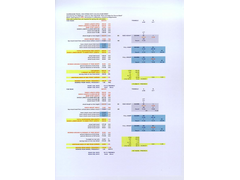smart51
|
| posted on 17/1/08 at 01:28 PM |

|
|
How to calculate required spring rate
I need to chose dampers and springs for my new project. How do I calculate the spring stiffness required?
The weight on each front wheel will be 95 - 100kg with me sat in it.
Are springs rated in lbs / in?
If I have a 100lb/in spring and have to compress it by 1 inch to fit it to my damper. does that mean it will support 100lbs before it starts to
compress further, then will compress by 1 inch for every extra 100lbs added?
|
|
|
|
|
Andy S
|
| posted on 17/1/08 at 03:22 PM |

|
|
Smart51
Yes you are correct - initial compression is called preload and its as you suspect that that load will need to be met then there is a linear
compression as you add weight
so 100lb will not move it then 200 will compress 1" etc.
For you car
What you need to calculate is the sprung weight which is as its states only the weight suported by the springs which is usuall some 100+kg less than
the car weight. more so with a live axle car
You also need to know the suspension leverage because its quite normal for the wishbone to be acting as a lever - this leverage ratio can be between
1:1 and 2:1 typically - there is also the coil lean angle to take into account which can halve the effective spring rate
Cheers
Andrew
|
|
|
thunderace
|
| posted on 17/1/08 at 04:47 PM |

|
|
this will let you work it out
http://www.andersensmith.freeserve.co.uk/suspension.htm
|
|
|
Bob C
|
| posted on 17/1/08 at 11:41 PM |

|
|
Spring rates should be calculated based on the desired resonant frequency of the on undamped oscillation. There is a tragedy of imperial units usually
going on - wheel rates in lbs/in, weights(masses) in kg and frequency in cpm (cycles per minute) but f is proportional to the square root of rate/mass
- the actual formula contains the fudge factors. cymtriks (on here) posted this a few years ago along with examples from "proper" cars. I
seem to remember normal cars being about 80cpm but 'sports' around 100 and 'race' 110 to 120 & the back slightly higher
frequency than the front, but it's all a bit hazy (esp. after 3 pints of banks....)
hope that's a bit helpful....
bob
|
|
|
Fred W B
|
| posted on 18/1/08 at 06:04 AM |

|
|
I did a spreadsheet for calculation of suspension travel and spring rate, from first principles, as described by Allan Staniforth.
If you email me I can send it to you, if you like.
Cheers
Fred WB
 
rates
[Edited on 18/1/08 by Fred W B]
You can do it quickly. You can do it cheap. You can do it right. – Pick any two.
|
|
|
smart51
|
| posted on 18/1/08 at 10:11 AM |

|
|
Thanks Fred, that's just great.
|
|
|













